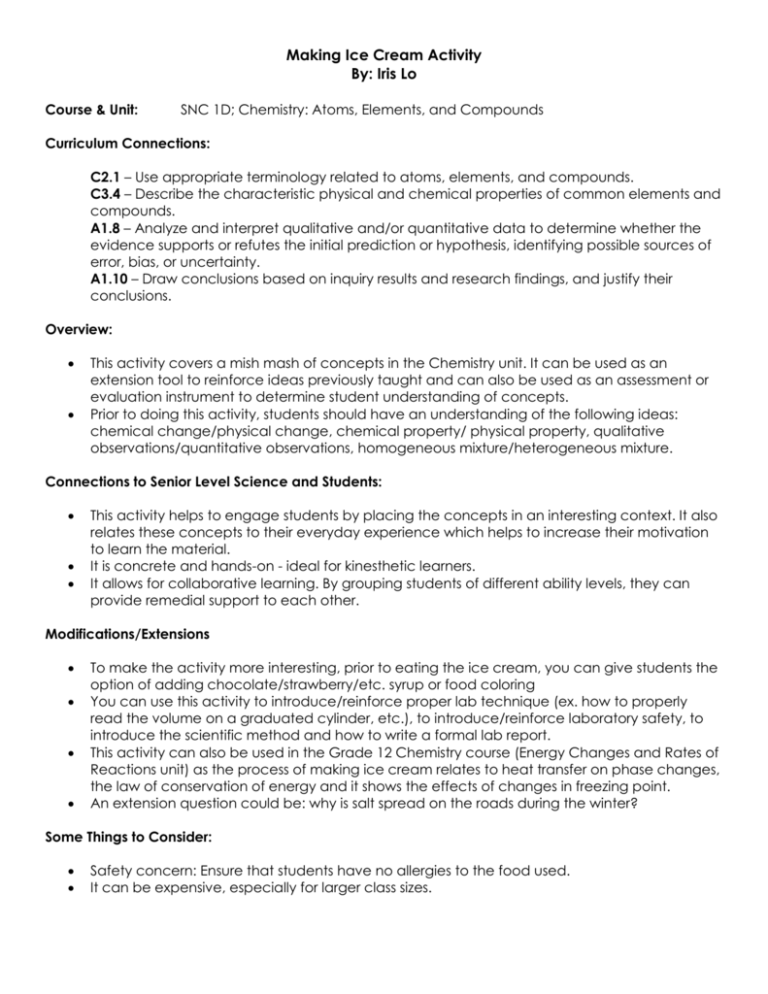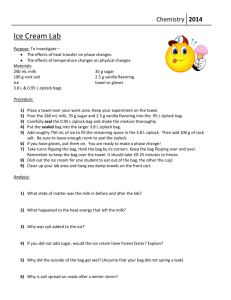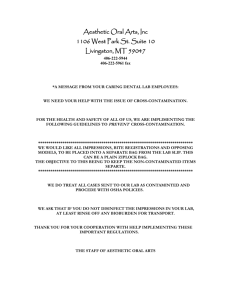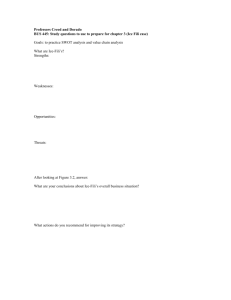Best Practice - Ice Cream Activity (Iris Lo)
advertisement

Making Ice Cream Activity By: Iris Lo Course & Unit: SNC 1D; Chemistry: Atoms, Elements, and Compounds Curriculum Connections: C2.1 – Use appropriate terminology related to atoms, elements, and compounds. C3.4 – Describe the characteristic physical and chemical properties of common elements and compounds. A1.8 – Analyze and interpret qualitative and/or quantitative data to determine whether the evidence supports or refutes the initial prediction or hypothesis, identifying possible sources of error, bias, or uncertainty. A1.10 – Draw conclusions based on inquiry results and research findings, and justify their conclusions. Overview: This activity covers a mish mash of concepts in the Chemistry unit. It can be used as an extension tool to reinforce ideas previously taught and can also be used as an assessment or evaluation instrument to determine student understanding of concepts. Prior to doing this activity, students should have an understanding of the following ideas: chemical change/physical change, chemical property/ physical property, qualitative observations/quantitative observations, homogeneous mixture/heterogeneous mixture. Connections to Senior Level Science and Students: This activity helps to engage students by placing the concepts in an interesting context. It also relates these concepts to their everyday experience which helps to increase their motivation to learn the material. It is concrete and hands-on - ideal for kinesthetic learners. It allows for collaborative learning. By grouping students of different ability levels, they can provide remedial support to each other. Modifications/Extensions To make the activity more interesting, prior to eating the ice cream, you can give students the option of adding chocolate/strawberry/etc. syrup or food coloring You can use this activity to introduce/reinforce proper lab technique (ex. how to properly read the volume on a graduated cylinder, etc.), to introduce/reinforce laboratory safety, to introduce the scientific method and how to write a formal lab report. This activity can also be used in the Grade 12 Chemistry course (Energy Changes and Rates of Reactions unit) as the process of making ice cream relates to heat transfer on phase changes, the law of conservation of energy and it shows the effects of changes in freezing point. An extension question could be: why is salt spread on the roads during the winter? Some Things to Consider: Safety concern: Ensure that students have no allergies to the food used. It can be expensive, especially for larger class sizes. Making Ice Cream Lab Purpose: To make qualitative observations of matter To describe the characteristic physical properties of matter To investigate physical and/or chemical change To investigate homogeneous and/or heterogeneous mixtures Hypothesis: As you make the ice cream, will you be observing a physical or chemical change? _________________________________________________________ Will the resulting ice cream be a homogeneous mixture or heterogeneous mixture? _________________________________________________________ Materials: 1 large ziplock bag 1 small ziplock bag Ice 80 mL of salt 2 drops of vanilla extract 100 mL of half and half cream 20 mL of sugar Spoons Cups (optional) Procedure: 1) Look at the ingredients you are using. Describe and record the physical properties of the matter you are looking at (ie. the ice, salt, sugar, cream, vanilla extract). Be descriptive – use the vocabulary and terms discussed in class. 2) In the small ziplock bag, add 100 mL of half and half cream, 20 mL of sugar and 2 drops of vanilla extract. Seal the bag. Describe and record your qualitative observations on the mixture. 3) In the large ziplock bag, half fill the bag with ice and add 80 mL of salt into the bag. 4) Put the small ziplock bag into the large ziplock bag and seal it. 5) Shake the bag for at least 5 minutes. 6) After at least 5 minutes of shaking, open the large ziplock bag and take out the small ziplock bag. Open the small ziplock bag. 7) Observe and record your observations of the contents of the small ziplock bag after being shaken for at least 5 minutes. 8) Taste your ice cream. Describe and record any additional observations you can add to the observations made in step 7. 9) Clean up. All materials can go into the garbage. Conclusion: 1) Define the terms ‘physical change’, ‘chemical change’, ‘homogeneous mixture’ and ‘heterogeneous mixture’. 2) What type of change (physical or chemical) did you observe? Explain how you came to this conclusion. 3) What type of mixture did you produce – homogeneous or heterogeneous? Explain how you came to this conclusion. 4) Was your hypothesis correct? Explain. 5) Describe the possible sources of error made during the activity.






